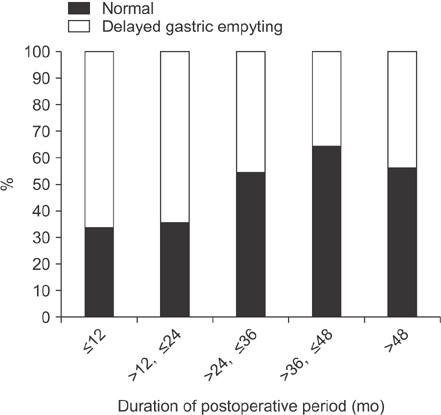Ann Surg Treat Res.
2017 Dec;93(6):310-315. 10.4174/astr.2017.93.6.310.
Clinical features of gastric emptying after distal gastrectomy
- Affiliations
-
- 1Department of Surgery, Chungbuk National University College of Medicine, Cheongju, Korea. yunhyo@chungbuk.ac.kr
- 2Department of Internal Medicine, Chungbuk National University College of Medicine, Cheongju, Korea.
- 3Department of Surgery, Chungbuk National University Hospital, Cheongju, Korea.
- 4Department of Internal Medicine, Chungbuk National University Hospital, Cheongju, Korea.
- KMID: 2396872
- DOI: http://doi.org/10.4174/astr.2017.93.6.310
Abstract
- PURPOSE
Gastric emptying may influence the quality of life of patients who undergo distal gastrectomy. Little is known, however, about gastric emptying after distal gastrectomy. The aim of our study was to investigate gastric emptying patterns after distal gastrectomy.
METHODS
This gastric-emptying study investigated patients who underwent distal gastrectomy in the 6 months or more before May 2008 to July 2013 at Chungbuk National University Hospital with a study sample of 205 patients. We analyzed patterns of gastric emptying.
RESULTS
Delayed gastric emptying was found in 109 of the 205 patients (53.2%). Food stasis was more frequent in a group with delayed gastric emptying. In multivariate analysis, risk factors for gastroparesis were laparoscopic operation (hazard ratio [HR], 2.731; P = 0.008) and duration of less than 24 months after distal gastrectomy (HR, 2.795; P = 0.001). Delayed gastric emptying tended to decrease with duration of the postoperative period.
CONCLUSION
Delayed gastric emptying is common in distal gastrectomy, and is related to laparoscopic operation and duration of the postoperative period. Food stasis was more frequent in a group with delayed gastric emptying.
Keyword
MeSH Terms
Figure
Reference
-
1. Jung KW, Won YJ, Kong HJ, Oh CM, Lee DH, Lee JS. Cancer statistics in Korea: incidence, mortality, survival, and prevalence in 2011. Cancer Res Treat. 2014; 46:109–123.2. Kim DH, Kim SM, Hyun JK, Choi MG, Noh JH, Sohn TS, et al. Changes in postoperative recurrence and prognostic risk factors for patients with gastric cancer who underwent curative gastric resection during different time periods. Ann Surg Oncol. 2013; 20:2317–2327.3. Onate-Ocana LF, AielloCrocifoglio V, MondragonSanchez R, RuizMolina JM. Survival benefit of D2 lympadenectomy in patients with gastric adenocarcinoma. Ann Surg Oncol. 2000; 7:210–217.4. Kim JP. Surgical results in gastric cancer. Semin Surg Oncol. 1999; 17:132–138.5. Urushihara T, Sumimoto K, Shimokado K, Kuroda Y. Gastric motility after laparoscopically assisted distal gastrectomy, with or without preservation of the pylorus, for early gastric cancer, as assessed by digital dynamic x-ray imaging. Surg Endosc. 2004; 18:964–968.6. Karanicolas PJ, Graham D, Gonen M, Strong VE, Brennan MF, Coit DG. Quality of life after gastrectomy for adenocarcinoma: a prospective cohort study. Ann Surg. 2013; 257:1039–1046.7. Seok JW. How to interpret gastric emptying scintigraphy. J Neurogastroenterol Motil. 2011; 17:189–191.8. Kubo M, Sasako M, Gotoda T, Ono H, Fujishiro M, Saito D, et al. Endoscopic evaluation of the remnant stomach after gastrectomy: proposal for a new classification. Gastric Cancer. 2002; 5:83–89.9. Lee HF, Chang FY, Lu CL, Luo JC, Chen CY, Wu HC. Electrogastrographic characteristics in subjects with stomach remnant. J Gastroenterol Hepatol. 2010; 25:339–344.10. Kim KH, Kim MC, Jung GJ. Risk factors associated with delayed gastric emptying after subtotal gastrectomy with Billroth-I anastomosis using circular stapler for early gastric cancer patients. J Korean Surg Soc. 2012; 83:274–280.11. Piessevaux H, Tack J, Walrand S, Pauwels S, Geubel A. Intragastric distribution of a standardized meal in health and functional dyspepsia: correlation with specific symptoms. Neurogastroenterol Motil. 2003; 15:447–455.12. Kim DH, Kim YC, Choi W, Yun HY, Sung R, Kim HS, et al. High K(+)-Induced relaxation by nitric oxide in human gastric fundus. Korean J Physiol Pharmacol. 2012; 16:297–303.13. Abu Dayyeh BK, Lautz DB, Thompson CC. Gastrojejunal stoma diameter predicts weight regain after Roux-en-Y gastric bypass. Clin Gastroenterol Hepatol. 2011; 9:228–233.
- Full Text Links
- Actions
-
Cited
- CITED
-
- Close
- Share
- Similar articles
-
- Risk factors associated with delayed gastric emptying after subtotal gastrectomy with Billroth-I anastomosis using circular stapler for early gastric cancer patients
- Gastric-Emptying Patterns after Gastroduodenal Reconstruction Preservation of the truncal vagus nerve
- Nursing Intervention for a Delayed Gastric Emptying after Pylorus-preserving Gastrectomy for Early Gastric Cancer
- Laparoscopic Distal Gastrectomy for Gastric Cancer
- Comparison of the Differences of Gastric Emptying Time After Upper Gastrointestinal Surgeries Using the Acetaminophen Method


